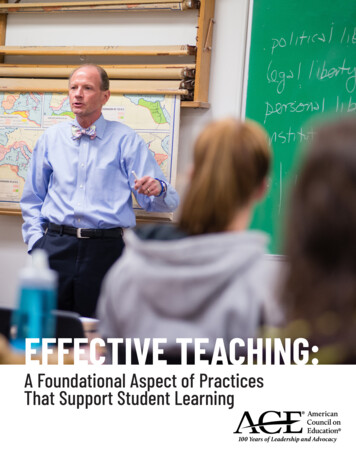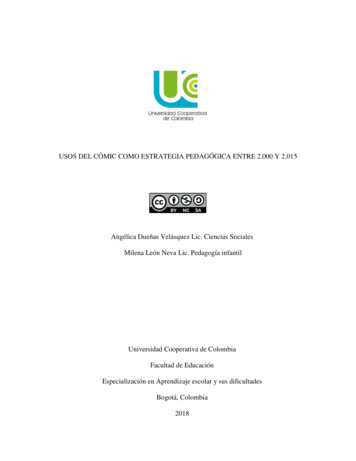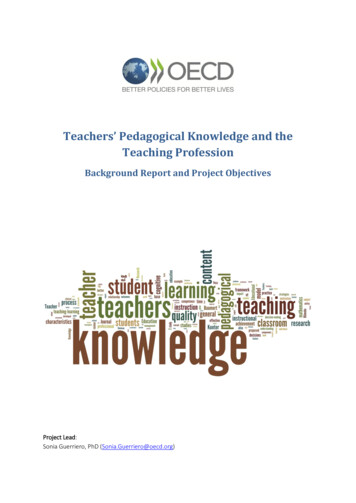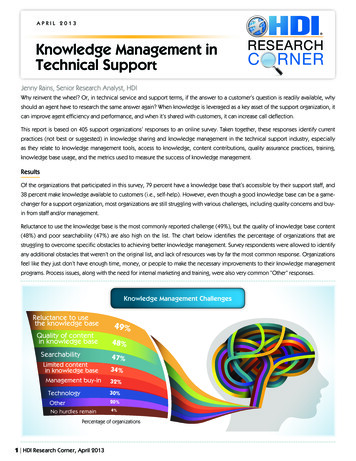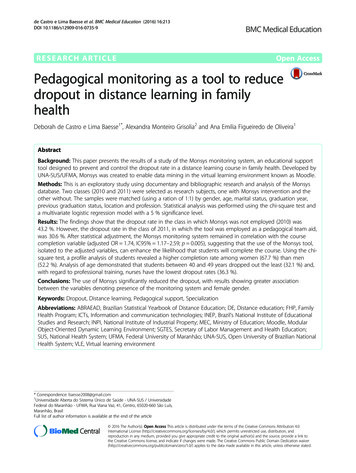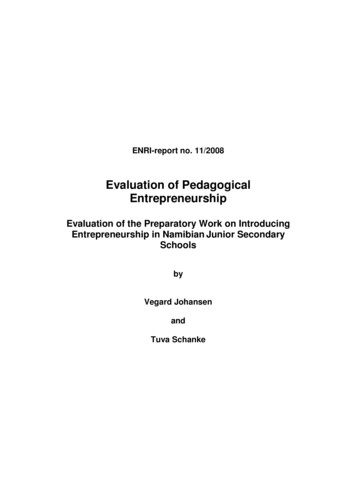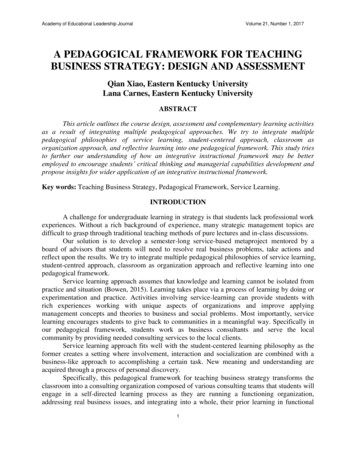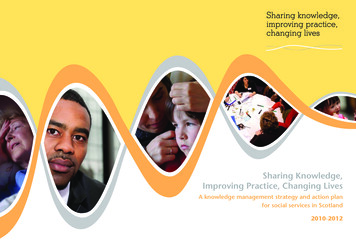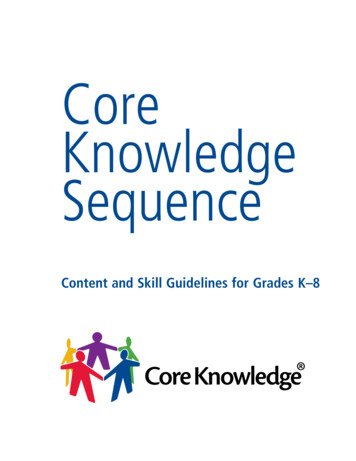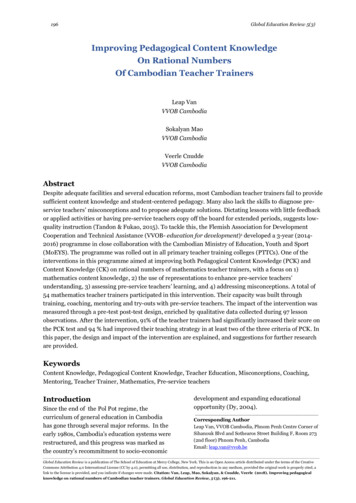
Transcription
196Global Education Review 5(3)Improving Pedagogical Content KnowledgeOn Rational NumbersOf Cambodian Teacher TrainersLeap VanVVOB CambodiaSokalyan MaoVVOB CambodiaVeerle CnuddeVVOB CambodiaAbstractDespite adequate facilities and several education reforms, most Cambodian teacher trainers fail to providesufficient content knowledge and student-centered pedagogy. Many also lack the skills to diagnose preservice teachers’ misconceptions and to propose adequate solutions. Dictating lessons with little feedbackor applied activities or having pre-service teachers copy off the board for extended periods, suggests lowquality instruction (Tandon & Fukao, 2015). To tackle this, the Flemish Association for DevelopmentCooperation and Technical Assistance (VVOB- education for development)1 developed a 3-year (20142016) programme in close collaboration with the Cambodian Ministry of Education, Youth and Sport(MoEYS). The programme was rolled out in all primary teacher training colleges (PTTCs). One of theinterventions in this programme aimed at improving both Pedagogical Content Knowledge (PCK) andContent Knowledge (CK) on rational numbers of mathematics teacher trainers, with a focus on 1)mathematics content knowledge, 2) the use of representations to enhance pre-service teachers’understanding, 3) assessing pre-service teachers’ learning, and 4) addressing misconceptions. A total of54 mathematics teacher trainers participated in this intervention. Their capacity was built throughtraining, coaching, mentoring and try-outs with pre-service teachers. The impact of the intervention wasmeasured through a pre-test post-test design, enriched by qualitative data collected during 97 lessonobservations. After the intervention, 91% of the teacher trainers had significantly increased their score onthe PCK test and 94 % had improved their teaching strategy in at least two of the three criteria of PCK. Inthis paper, the design and impact of the intervention are explained, and suggestions for further researchare provided.KeywordsContent Knowledge, Pedagogical Content Knowledge, Teacher Education, Misconceptions, Coaching,Mentoring, Teacher Trainer, Mathematics, Pre-service teachersIntroductionSince the end of the Pol Pot regime, thecurriculum of general education in Cambodiahas gone through several major reforms. In theearly 1980s, Cambodia’s education systems wererestructured, and this progress was marked asthe country’s recommitment to socio-economicdevelopment and expanding educationalopportunity (Dy, 2004).Corresponding AuthorLeap Van, VVOB Cambodia, Phnom Penh Centre Corner ofSihanouk Blvd and Sothearos Street Building F, Room 273(2nd floor) Phnom Penh, CambodiaEmail: leap.van@vvob.beGlobal Education Review is a publication of The School of Education at Mercy College, New York. This is an Open Access article distributed under the terms of the CreativeCommons Attribution 4.0 International License (CC by 4.0), permitting all use, distribution, and reproduction in any medium, provided the original work is properly cited, alink to the license is provided, and you indicate if changes were made. Citation: Van, Leap, Mao, Sokalyan, & Cnudde, Veerle (2018). Improving pedagogicalknowledge on rational numbers of Cambodian teacher trainers. Global Education Review, 5 (3), 196-211.
Pedagocical content knowledge of Cambodian teacher trainers197In the period 1979-1986, the general(2) teacher training for primary school teacherseducation system consisted of 10 years (4 3 3):at Provincial Teacher Training Centers (PTTCs);four years of primary education, three years of(3) teacher training for lower-secondary teacherslower secondary education, and three years ofat Regional Teacher Training Center (RTTC);upper secondary education (Hang, 2016). In theand (4) teacher training for upper secondary1986-1996 period, the system changed into anteachers at the National Institute of Education11-year (5 3 3) trajectory. From 1996 onwards,(NIE).the general education system contained 12-yearsThe Teacher Policy Action Plan (MoEYS,in school (6 3 3). There has been a shortage of2015) is a multiyear plan intended to bringqualified teachers throughout these reforms andCambodian education into the 21st century. Thisthe recruitment of teachers and teacher trainersambitious plan includes, among other changes, awas not well-structured.reform of the teacher training curriculum into aAs stated in Hang (2016), teacher training4-year bachelor, the development of Teacherin the early eighties consisted mainly of shortEducator Provider Standards and thecourses to upgrade the knowledge of formerestablishment of a Teacher Career Pathway, allteachers, students and educated individuals whoelements in the educational reform intended tohad survived the Pol Pot regime. The duration ofbring Cambodian education closer to thethese training courses varied between one andinspiring level of several Association ofthree months. In 1983, the Ministry ofSoutheast Asian Nations (ASEAN)2 countries.Education published teacher standards forDue to the impact of Pol Pot’s regime andpreservice preschool and primary schools. In thethe above described reforms in generalfirst phase, becoming a primary school teachereducation and teacher training, the backgroundinvolved the completion of grade 7 followed byof today's teacher trainers at the PTTCs is veryone year of teacher training. Due to the lack ofdiverse. Some of the teacher trainers startedteachers, these standards were reduced in sometheir career as primary school teachers beforedisadvantaged and remote areas to one year ofentering PTTC. Others finished only lowerteacher training after completing grade 5 or evensecondary school (grade 7, or 8 or 9) while somegrade 3.finished upper secondary school (grade 11 or 12)Between 1986 and 1996 the requirementsand graduated from the two-year teacherfor graduating as a primary school teacher weretraining programme from either PTTCs orchanged: pre-service teachers needed at leastRTTCs. Some teacher trainers graduated fromnine years of basic education to enter a two-yearuniversity with a bachelor’s degree andteacher training course, for lower secondary itcontinued a one-year pedagogical training atwas 11 years plus 2 additional years, and forNIE. These different levels of qualifications areupper secondary teachers a foundation of 11also reflected in teacher trainers’ understandingyears schooling was needed to enter a 3 -yearof math. Research shows different levels of CKteacher training course.and PCK. Literature suggests that to provideSince 1996, the trajectory to become ainsightful instruction, CK is not sufficient; itprimary school teacher is 12 years of generalrequires PCK, which involves teachers’education (9 years for disadvantaged and remoteunderstanding which combines knowledge ofprovinces) followed by 2 years of teachersubject content, of students’ understanding, andtraining. Teacher Training Centers (TTCs) inof pedagogy (Ball, Lubienski, & Mewborn, 2001;Cambodia are comprised of four categories: (1)Baumert et al., 2010; Kunter et al., 2013; Rowanteacher training for pre-school teachers at theet al., 2001).Pre-School Teacher Training Center (PSTTC);In addition, there is a significant
198Global Education Review 5(3)relationship between the PCK of primary schoolboard for extended periods (Tandon & Fukao,teachers’ and grade 3 learners’ achievements in2015).Cambodia (Ngo, 2013). PCK of teachers has theTo tackle this, VVOB developed a 3-yearlargest impact (of several elements defined as(2014-2016) programme in close collaborationpart of ‘teacher quality’) on learning outcomes,with the Cambodian Ministry of Education,even when you control for learner and schoolYouth and Sport (MoEYS). One of thecharacteristics. However, in the lowest quintilesinterventions in this programme aimed toof pupil scores, teacher quality is not asimprove both PCK and CK on rational numberssignificant as student background or schoolof mathematics teacher trainers. The impact ofcharacteristics in predicting studentthe intervention was measured through a pre-achievement. These findings strongly suggesttest post-test design, enriched by qualitativethat, compared to other elements of teacherdata collected during lesson observations.quality, teacher PCK is a strong predictor oflearners’ achievement in mathematics. LearnersDescription of the Interventionwill benefit from having a teacher who is able toThe VVOB-MoEYS Cooperation Program wasidentify pupil errors and who has deeperdesigned to strengthen the quality of pre-serviceknowledge of mathematical reasoning. Inteacher training for primary education inaddition, previous studies suggest that teacherCambodia. This intervention fits in with thetraining and professional development systemoverall objective, to strengthen primary schoolfor teacher trainers strengthen both subject andteacher education in order to improve learningPCK (Benveniste, Marshall, & Araujo, 2008;outcomes in mathematics for all learners. ToKleickmann et al., 2013).ensure the quality of primary teacher education,Despite the evidence of the importance ofPTTCs play an important role in training theteachers’ PCK for pupils’ learning outcomes, theprospective primary teachers. The interventionPCK of mathematics teacher trainers inprogramme, therefore, included all mathematicsCambodia was reported to be very limitedteacher trainers from 18 PTTCs.(Tandon & Fukao, 2015). Tandon and FukaoThe intervention described in this paper(2015) also found that many teacher trainers hadaimed at improving both PCK and CK oneven lower knowledge of math than grade 9rational numbers of mathematics teacherpupils, which resulted in limited capacity totrainers, with a focus on 1) mathematics contentdiagnose students’ mistakes and to generateknowledge, 2) the use of representations toeffective learning of future teachers. Anenhance students’ understanding, 3) assessingessential teacher ability is to understandpre-service teachers’ learning, and 4) addressingstudents’ mathematical thinking, includingmisconceptions following the concepts ofcommon errors made by students, and theShulman (1986). Rational numbers are amongstimportance of students’ misconception of theirthe most difficult topics in the elementary schoolprogress and achievement in the test (Hill, Ballcurriculum, and teaching that topic requires anand Schilling 2008; Sarwadi & Shahrill, 2014).adequate knowledge base for teachers toMany teacher trainers did not have the skills toproperly deal with students' difficulties, so it wasdiagnose misconceptions and to proposeselected for the intervention.adequate solutions for their pre-service teachers.A total of 54 mathematics teacher trainersLow quality instructional methods are still usedparticipated in this intervention. The capacityby many teacher trainers, such as dictatingbuilding trajectory started in May 2014 and waslessons with little feedback or applied activities,completed in August 2016. The course took 23and having pre-service teachers copy off thedays consisting of 15-day input training and 8-
Pedagocical content knowledge of Cambodian teacher trainers199day refresher training. Try-out sessions withThe focus of these follow-up visits was on:pre-service teachers were embedded in allassessment of learning, addressing thetrainings.misconceptions, and using the representation inThe 23-day course consisted of: the mathematics lesson. In the meantime,A 5-day module on rationalteacher trainers also reflected and translatednumbers, based on the Basiccontent of their lessons into how prospectiveEducation and Teacher Trainingteachers apply the instructional strategies. Eachmanuals (MoEYS, 2011)observation was a part of coaching processA 5-day module on how to produceconsisting of constructive feedback, followingand use teaching aids for math inthe structures of the 6 feedback steps (MoEYS,primary education and a 4-day2016). Recordings were also used to analyze therefresher trainingchallenges of math teacher trainers; these issuesA 5-day module on formativewere tackled during the following training orassessments for primary educationreflection sessions.and a 4-day refresher trainingThe training was facilitated by a coreteam of 12 experts in mathematics, attached todifferent departments within the CambodianMinistry of Education (Teacher TrainingDepartment, Department of CurriculumDevelopment, Primary Education Departmentand Provincial Teacher Training Colleges).Participants were divided into groups of 25 and30 participants per two facilitators. PTTCmanagement in charge of technical teachingwere invited to these training sessions inaddition to math teacher trainers. Besidesessions on understanding specific math topics,participants had a chance to tryout the contentwith their pre-service teachers and their peers,to apply peer learning, and to share theirexperiences during subject group meetings intheir own Teacher Training College.The second part of the learning trajectoryconsisted of coaching and mentoring sessions,based on lesson observations. The samemathematic core team observed the lesson ofteacher trainers in each PTTC. After each lessonobservation, they provided coaching andmentoring to the teacher trainers to encouragescollaborative and reflective practice. Coachingallowed teacher trainers to apply their learningmore deeply, frequently, and consistently thanworking alone. Each teacher trainer wasobserved twice during the learning trajectory.Measuring the Impact of theInterventionAssessment Tools1.Pedagogical Content Knowledge andContent Knowledge TestDepaepe et al. (2015) developed the test in linewith the Cambodian context to gatherinformation about the level of mathematicsteacher trainers’ CK and PCK. Depaepe et al.(2015) defined CK of rational number asconceptual and procedural knowledge about therational numbers domain, as well as, PCK asknowledge of students' misconceptions andbuggy procedures about rational numbers and ofmultiple representations to prevent and/orremedy these misconceptions and buggyprocedures. The definitions of PCK and CK arein alignment with Shulman’s conceptualizationof PCK (Shulman, 1986).The test was composed of 48 questionswith 50% PCK questions and 50% CKquestions. Depaepe et al. (2015) distinguishedbetween two types of PCK items, namely (1)knowledge of students’ misconceptions and (2)knowledge of instructional strategies andrepresentations. In addition, questions werecategorized in two domains of rational numbers:fractions (50%) and decimal numbers (50%).More detailed information is shown in Table 1.Each item has a maximum score “1”, for an
200Global Education Review 5(3)entirely correct answer. In case of an incorrectproviding constructive feedback. The coachinganswer, “0” was assigned. On the questionssessions were structured using 6 steps: 1)related to operation, answers were scored “1/2”introduction, 2) the coaches shares the results ofif they were partly correct. This is shown intheir teaching, 3) coach give feedback, 4) theTable 1.coach ask the coachees to respond to thefeedback, 5) both parties discuss the ways for2. Lesson Observation Checklistimprovement, 6) Round up: remainingThe forms used to observe lessons consisted ofquestions and making an appointment for thetwo parts. The first part of the observationnext meeting (MoEYS, 2016). Each session tookchecklist captures parts of the lesson linked to30 minutes and gave the teacher trainer theeach of the following categories: (1) Teachingchance to reflect on their lesson and teachingmethodologies, (2) Teaching aids, (3) Learningstrategy.content and lesson objective (knowledge, skills,The second part of the observation formattitude), (4) Student assessment strategies, (5)consisted of a scoring grid (see snapshot below).Pupil’s behaviour (level of involvement andBased on the information collected in part oneactivity), (6) Pupil’s learning outcomesand the discussion after the lessons, the core(remembering/team gave a score to three selected PCK /judassessment, misconception, and representation.ging) and (7) General lesson characteristicsThe assessment part had 4 sub-criteria with a(structure, build-up, etc). The informationtotal score of 12, the misconception partwritten down in this checklist was used for thereflection after the lesson.The core team would use written notes asthe base for the reflection sessions whichfollowed, including coaching, mentoring andTable 1Design of the CK and PCK test: distinguished subdomains and number of tion211Division211ConceptOperationsDecimal numbersPCKConceptOperationsTotal2424
Pedagocical content knowledge of Cambodian teacher trainers201had 3 sub-criteria with a total score of 9, and1 to 3, with a score of “1” being the lowest score,representation had 4 sub-criteria with a total“2” the medium score, and “3” the highest score.score of 12. The scoring table described clearlyThe table also allowed for adding a justificationwhat needed to be observed for every level, andfor the score given, by adding examples in thefor each score. All sub-criteria were scored from‘Proof’ column.Table 2Snapshot of scoring grid for PCK criteria ‘Misconception’CriteriaCodeGrading scaleProofLevel 1Level 2Level 3The teacherThe teacher helpsThe teacher triesdoesn’t paystudents whento understand theattention tothey have made astudents’ thinkingmistakes.mistake byand helps themrepeating orby explaining it inreferring toa different way.MisconceptionsB1procedures.e.g. use ofteaching aids tosupport theweaker students.B2The teacherThe teacherThe teacherdoesn’t checkchecks the priorchecks thepriorknowledge ofunderstanding ofknowledge onstudents.prior knowledge.the topic.e.g. Why did youput both fractionson the samedenominator?B3The onlyThe teacher asksThe teacher asksquestions thatsome thinkingmany thinkingare used referquestions.questionsto knowledge.e.g. Why can’t wejust add thenumerators anddenominators?
202Global Education Review 5(3)Pre-Post Test Designformative assessment techniques, to addressingAll respondents were assessed using a pre-testthe misconceptions, and use of thepost-test design on PCK/CK. The pretest wasrepresentation. Moreover, another achievementadministered in May 2014, the post-test inwas measured by pre and post-test of PCK. AAugust 2016. Both were administered by thepaired t-test was performed to compare thecore team of 12 math experts under themean score of both tests. Achievement wassupervision of VVOB project staff. The samemeasured to determine if post-test scoresteam was also responsible for correcting andincreased significantly compared to pre-testscoring the test. The testing phase was dividedscores, at significant level 0.05 .into two parts, the time allowed for each part (24questions) was 120 minutes. To assureResultsanonymity, VVOB collected all PCK-test formsAs described above the impact of theand names were replaced by code before theintervention was measured through a pre-test -correction process started.post-test design; a group of 33 teacher trainersIn total 54 teacher trainers completed thecompleted both tests. The paired-sample T-testpre-test, of those only 33 finished the post-test.found that the mean of the overall score on theThe attrition was caused by different reasonspost-test (M 33.2, SD 7.5) of teacher trainers issuch as retirement, workplace change, and jobsignificantly higher than their score in pre-testpromotion. Besides assessing the tests, the(M 27.3, SD 7.5), with significant increase ofproject team also observed a lesson of each5.9 (95%CI: 3.94-7.93, p 0.001, t(32) 6.044).teacher trainer before, during and after theThe preliminary analyses show a greatintervention to measure the progress anddisparity between the scores of the teacherimpact. In total 97 lessons were observed duringtrainers. Descriptive data analysis showed thatthethree-year program. The forms used for thesefemale teacher trainers performed better thanobservations were the same as the observationstheir male peers in both pre-test and post-test,tools used during the intervention for the follow-however this difference was not significant.up visits, but on these occasions, not used with aWe also saw that the mean scores ofcoaching purpose. The focus of the pre-post(young) teacher trainers with less years ofobservations was on using representations,teaching experience, was higher than theirmisconceptions, and assessment.senior peers in both pre-test and post-test. Aclarification for this result could be found in theData Analysiseducational background of the teacher trainers.Descriptive and inferential statistics wereAll young teacher trainers had graduated fromconducted on data set. Percentage and frequencyuniversity with a bachelor’s degree, while mostwere used to describe respondents’ informationof the senior teacher trainers graduated from abackground related to the qualifications, years of2-year programme at a teacher training college.experience, socio-demographic information, andthe progress of achievement scores from lessonobservation focusing on how to apply the
203Global Education Review 5(3)Table 3Mean score by gender, years of experience and qualificationMeanscoreMean 26.8 (8.0)32.1 (7.9)Female528.2 (5.7)36.6 (5.1)Less or equal to 5 years627.6 (6.5)35.2 (5.0)Equal or more than 6 years2727.2 (7.8)32.8 (7.9)Master1027.3 (8.6)35.9 (8.0)Bachelor1328.5 (7.3)33.7 (5.7)Teacher Training certificate1025.7 (7.0)29.9 (8.5)3327.3 (7.5)33.2 (7.5)Categories of participantsNumberGenderMaleYears of experienceQualificationOverall score**Mean score after intervention is significantly higher than before intervention (p 0.001)When we looked closer at the differencesthe scores on related to pure content knowledgebetween PCK and CK tests, we noticed teacheritems. During coaching sessions, teacher trainerstrainers scored better in both on the post-testindicated that they had more difficultycompared to the pre-test. The paired sample t-answering the questions related to PCK than thetest showed a significant increase on both meanCK items. Looking closer at the responses withinscore of CK (p 0.001, t(32) 4.165) items withthe PCK items, we see teacher trainers struggled95% confident interval of difference: 1.03-3.02more with instructional strategies andand PCK (p 0.001, t(32) 5.493) items with 95%representation (mean 6.3, SD 2.7) thanconfident interval of difference:2.45-5.35 afterexplaining students’ misconception (mean 8.0,intervention. We noticed the scores onSD 2.4) after intervention(t(32) -4.64,pedagogical content knowledge items increasedp 0.001). More details can be found in Table 4.much more (t(32) 2.6, p 0.014) , compared to
204Global Education Review 5(3)Table 4Comparison of PCK test items and CK test items (pre-test and post-test)Mean scoreMean(SD)DifferenceTest items categories95% CIPPre-testPost-test(SD)10.4 (4.5)14.3 (4.7)3.9 (4.1)2.5-5.4 0.001*5.6 (2.8)8.0 (2.4)2.4 (2.7)1.5-3.4 0.001*4.9 (2.3)6.3 (2.7)1.5 (2.3)0.7-2.30.001*16.8 (3.8)18.9 (3.2)2.0 (2.8)1.0-3.0 0.001*Concept3.9 (2.1)5.4(1.8)1.5 (0.4)0.8-2.2 0.001*Operation13.0(2.3)13.1(2.0)0.1 (1.9)-0.6-0.80.7PCK itemsKnowledge ofstudents’misconceptionKnowledge ofinstructionalstrategies andrepresentationCK items* Statistically significant increase, at significant level 0.05Table 5Progress on PCK/CK of fractionsFraction test itemsPCK itemsMean scoreMean(SD)Difference95% CIP2.6 (2.1)1.8-3.3 0.001*3.8 (1.6)1.4 (1.5)0.6-1.7 0.001*1.6 (1.1)3.0 (1.5)1.4 (1.3)1.0-1.9 0.001*Pre-testPost-test(SD)4.2 (2.2)6.8 (2.6)2.6 (1.3)Knowledge ofstudents’misconceptionKnowledge ofinstructionalstrategies andrepresentationCK items7.8 (2.1)9.0 (2.1)1.2 (1.9)0.6-1.90.01*Concept1.7 (1.3)2.6 (1.2)1.0 (1.6)0.4-1.50.001*Operation6.2 (1.4)6.1 (1.5)–0.2(1.4)–0.7-0.40.5* Statistically significant increase, at significant level 0.05
205Global Education Review 5(3)Table 5 provides a closer look at theitems (t(32) 2.644 , p 0.013) after receivingdifferences between progress made related tocapacity development. Nevertheless, they stillunderstanding and teaching fractions comparedstruggled more with PCK items related toto teaching and understanding decimalsdecimal numbers than CK items in both pre-testnumbers. Table 5 shows the scores on both PCK(t(32) -6.888, p 0.001)) and post-test (t(32) -and CK items on the questions about fractions.7.104, p 0.001)). Teacher trainers performedTeacher trainers performed significantly betterbetter on knowledge of students’ misconceptionon both PCK (t(32) 3.73, p 0.01)and CK(t(32) 3.954 , p 0.001) after intervention, butitems(t(32) 6.9, p 0.001) for fractions afterthey made no significant progress regarding theintervention. However, no significant increaseknowledge of instructional strategies andwas found if we consider the scores for CK itemsrepresentations (t(32) 0.99 , p 0.922). Therelated to operations with fractions. This can behigh score of CK on operation with decimalexplained by already high scores at the start ofnumbers (almost 7 on a maximum score of 8) isthe intervention, approximately 6 over the scaleremarkable, although it is not statisticallyof 8, in both pre-test and post-test.significant.Teacher trainers had more difficulty withTable 7 presents the most challenging PCKfraction PCK items than fraction CK items initems and CK items for teacher trainers, evenboth pre-test (t(32) -7.516, p 0.001) and post-they have taken a training course on rationaltest (t(32) 10.34, p 0.001). However, meannumber. The teacher trainers had more difficultyscores of fraction PCK (t(32) 6.901, p 0.01)putting the fraction into words, and matchingitems and fraction CK (t(32) 3.73 ,p 0.01 itemsthis with the corresponding section in the wordwere significantly higher after intervention.problem. This challenge indicated that they hadTable 6 shows that teacher trainerslimited knowledge about how to translate real-performed significantly better on decimal CKlife word problems into number sentences oritems (t(32) 2.548, p 0.016) and decimal PCKvice versa, for example PCK item 1 and CK itemTable 6Progress on PCK/CK of decimal numbersMean score(SD)Decimal test itemsMeanDifference(SD)95% CIPPre-testPost-test6.2 (2.9)7.6 (2.5)1.3 (2.9)0.3-2.30.013*2.9 (1.8)4.2 (1.4)1.3 (0.3)0.6-2.0 0.001*3.3 (1.6)3.3 (1.6)0.0 (1.8)–0.6-0.60.9229.0 (2.1)9.8 (1.6)0.8 (1.8)0.2-1.50.016*Concept2.2 (1.1)2.8 (1.1)0.5 (0.9)0.2-0.90.001*Operation6.8 (1.5)7.1 (1.0)0.3 (1.4)–0.2-0.80.271PCK itemsKnowledge ofstudents’misconceptionKnowledge ofinstructionalstrategies andrepresentationCK items* Statistically significant increase, at significant level
206Global Education Review 5(3)Table 7 The most difficult questions of PCK items and CK items after interventionPCK/CKItems% correctresponseGiven:35 14 7201.Indicate and explain for each of the below mentioned word problems whetheryou would use them in your classroom to contextualize the above-mentionedPCK15.2operation.a)31of a cake was used by dad. Sopheak and Sophy eat togetherof the54remaining part of the cake. How much of the cake have they eaten?b) To fill a water basin we need1of a completely filled open well. Today4the open well is only filled for3. How much water remains in the5open well after the water basin is filled?c) When frying vegetable dad uses31of a small bottle of chili sauce and54of a small bottle of soya sauce. How much chili and soya sauceremains?2.These are illustrations of elementary students’ solutions.Samnang’s solutionChampey ‘s solutionMalis’s solutionDetermine the right or wrong solution. In case of a wrong solution, write down24.4the presumable student’s reasoning.1.If the rectangle below is6of the surface of the original shape, draw the5original shape.45.5CK2.Write down and solve the mathematical operation with fractions that fits thefollowing problem:41Somaly madeliter of fresh fruit juice. She gaveto her mother.45How many liter of fresh fruit juice did her mother receive?45.5
207Global Education Review 5(3)2 in table 7. After intervention, roughly 15% ofeventually in relation to second observation. Theteacher trainers answered PCK item 1 correctlyscore of the final lesson observation graduallyand 45% of teacher trainers correctly answeredincreased in comparison to the previous three.CK item 2. Understanding how to addressFluctuations in the score of the thirdstudents’ misconception or difficulties remainedobservations were caused by an increase ofa challenge for mathematics teacher trainersteacher trainers in the cohort. Those additionalafter the intervention. As a result, approximatelyteacher trainers were not mentored and coachedone-fourth of them could explain students’by the expert team in the first and second lessonreasoning or misconception, when studentsobservations so their achievement score fromprovided a wrong answer.lesson observation were lower than their peersAfter intervention, roughly 15% of teacherincluded from the beginning in the learningtrainers answered PCK item 1 correctly and 45%trajectory. This indicated once more theof teacher trainers correctly answered CK item 2.importance of coaching and mentoring forUnderstanding how to address students’strengthening teachers’ capacity. Teachers alsomisconception or difficulties remained aconfirmed during the evaluation of thechallenge for mathematics teacher trainers afterprogramme how beneficial the coaching sessionsthe intervention. As a result, approximately one-after each lesson observation were for improvingfourth of them could explain students’ reasoningtheir future teaching.or misconception, when students provided awrong answer.In addition, teacher trainers hadLooking at the data in Table 3 and Table 6,it becomes clear that the use of representationsduring math lessons is the most challeng
teacher training course. Since 1996, the trajectory to become a primary school teacher is 12 years of general education (9 years for disadvantaged and remote provinces) followed by 2 years of teacher training. Teacher Training Centers (TTCs) in Cambodia are comprised of four categories: (1) teacher training for pre-school teachers at the
